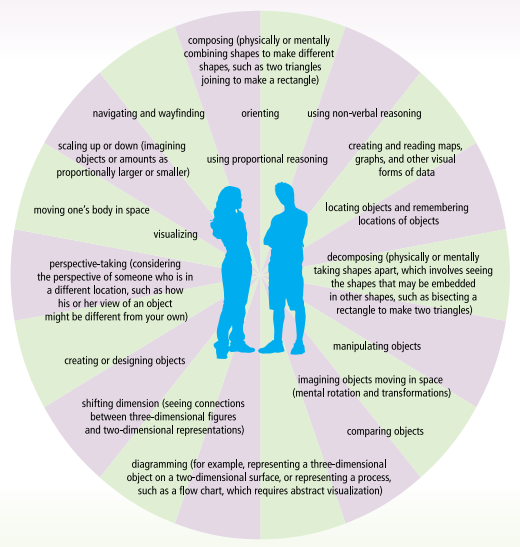Strengthening Spatial Ability = Success in MathThe ability to use spatial reasoning or to spatialize math is important as it supports the building of deep conceptual knowledge and the ability make connections between mathematical concepts. It supports learning and communication of thinking and understanding across the strands in the curriculum.
The good news for students and teachers alike is that research shows that spatial reasoning is malleable and can be developed at any age! (Utall et. all, 2013) |
Manipulatives - Why are they so important?Math tools support learning for students in many different ways. They help to deepen conceptual understanding as well as help to solve problems. Manipulatives help to create mental pictures that help to solve problems through visualizing.
Students can move between concrete ideas and abstract ideas when using math tools. Seeing concrete representations and testing ideas through tactile manipulations also helps individuals to uncover misconceptions. If used consistently they also provide visual models that can be mentally manipulated. Educators also need to experience explorations with manipulatives. We often experience our own mathematical surprises and new understandings as we use tools to help us understand how the materials reveal important mathematical concepts. |
Paying Attention to Spatial ReasoningTo support the "Paying Attention to Mathematics Education" document the Ontario Ministry of Education released "Paying Attention to Spatial Reasoning". The following reasons are given for the need for the emphasis on developing spatial reasoning in learners:
The complete document can be found here. |
Resources
Ansari, D. (2013). Disorders of the “mathematical brain”: Developmental dyscalculia and mathematics anxiety. Keynote address:
Ontario Association of Mathematics Educators, Seneca College, Toronto, ON.
Casey, B., Erkut, S., Ceder, I., & Young, J. (2008). Use of a storytelling context to improve girls’ and boys’ geometry skills in kindergarten. Journal of Applied Developmental Psychology, 29, 29–48.
Jordan, N., & Levine, S. (2009). Socioeconomic variation, number competence, and mathematics learning difficulties in young children. Developmental Disabilities Research Reviews, 15, 60–68.
Mix, K. S., & Cheng, Y.-L. (2012). The relation between space and math: Developmental and educational implications. In J. B. Benson (Ed.), Advances in child development and behavior (Vol. 42, pp. 197–243). San Diego, CA: Academic Press.
Spatial Reasoning in Number Sense and Numeration – VIDEO. (n.d.). Retrieved May 22, 2016, from
http://learnteachlead.ca/projects/spatial-reasoning-number-sense-numeration/?pcat=999
Uttal, D. H., Meadow, N. G., Tipton, E., Hand, L. L., Alden, A. R., Warren, C., & Newcombe, N. S. (2013). The malleability of spatial skills: A
meta-analysis of training studies. Psychological Bulletin, 139(2), 352.
Verdine BN, et al. Finding the missing piece: Blocks, puzzles, and shapes fuel school readiness. Trends in Neuroscience and Education (2014), http://dx.doi.org/10.1016/j.tine.2014.02.005i
Ontario Association of Mathematics Educators, Seneca College, Toronto, ON.
Casey, B., Erkut, S., Ceder, I., & Young, J. (2008). Use of a storytelling context to improve girls’ and boys’ geometry skills in kindergarten. Journal of Applied Developmental Psychology, 29, 29–48.
Jordan, N., & Levine, S. (2009). Socioeconomic variation, number competence, and mathematics learning difficulties in young children. Developmental Disabilities Research Reviews, 15, 60–68.
Mix, K. S., & Cheng, Y.-L. (2012). The relation between space and math: Developmental and educational implications. In J. B. Benson (Ed.), Advances in child development and behavior (Vol. 42, pp. 197–243). San Diego, CA: Academic Press.
Spatial Reasoning in Number Sense and Numeration – VIDEO. (n.d.). Retrieved May 22, 2016, from
http://learnteachlead.ca/projects/spatial-reasoning-number-sense-numeration/?pcat=999
Uttal, D. H., Meadow, N. G., Tipton, E., Hand, L. L., Alden, A. R., Warren, C., & Newcombe, N. S. (2013). The malleability of spatial skills: A
meta-analysis of training studies. Psychological Bulletin, 139(2), 352.
Verdine BN, et al. Finding the missing piece: Blocks, puzzles, and shapes fuel school readiness. Trends in Neuroscience and Education (2014), http://dx.doi.org/10.1016/j.tine.2014.02.005i

